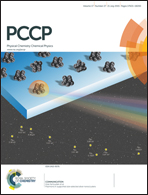Selectivity of pyoverdine recognition by the FpvA receptor of Pseudomonas aeruginosa from molecular dynamics simulations†
Abstract
The Gram-negative bacterium Pseudomonas aeruginosa, a ubiquitous human opportunistic pathogen, has developed resistances to multiple antibiotics. It uses its primary native siderophore, pyoverdine, to scavenge the iron essential to its growth in the outside medium and transport it back into its cytoplasm. The FpvA receptor on the bacterial outer membrane recognizes and internalizes pyoverdine bearing its iron payload, but can also bind pyoverdines from other Pseudomonads or synthetic analogues. Pyoverdine derivatives could therefore be used as vectors to deliver antibiotics into the bacterium. In this study, we use molecular dynamics and free energy calculations to characterize the mechanisms and thermodynamics of the recognition of the native pyoverdines of P. aeruginosa and P. fluorescens by FpvA. Based on these results, we delineate the features that pyoverdines with high affinity for FpvA should possess. In particular, we show that (i) the dynamics and interaction of the unbound pyoverdines with water should be optimized with equal care as the interface contacts in the complex with FpvA; (ii) the C-terminal extremity of the pyoverdine chain, which appears to play no role in the bound complex, is involved in the intermediate stages of recognition; and (iii) the length and cyclicity of the pyoverdine chain can be used to fine-tune the kinetics of the recognition mechanism.


 Please wait while we load your content...
Please wait while we load your content...